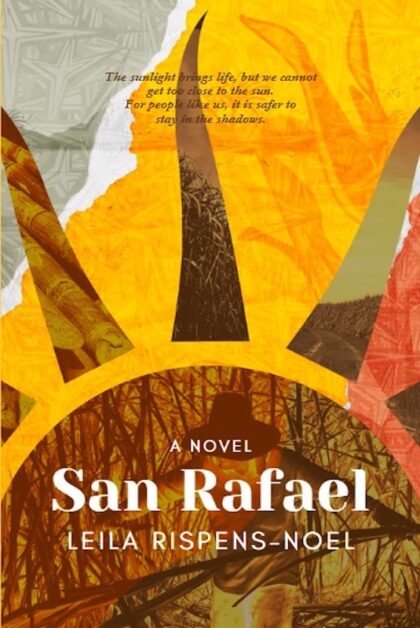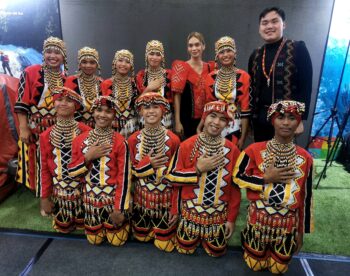
BOOK REVIEW: San Rafael by Leila Rispens-Noel
8 Letters Bookstore & Publishing, 2023
One sweltering afternoon, Isabel headed for the lagoon. She walked through a rocky narrow track with dense cogon and other grasses on either side. Ice-cold water cascaded down the rocky hill, its roar filling the air. The water was crystal clear-clear enough to make out the rocks and pebbles on the bottom. Towering and lush trees surrounded the waterfall, which provided a refreshing respite from the sun. Ferns and mosses grew in the crevices of the boulders adding to the breathtaking natural highland landscape. – Chapter 1, 1969 Buenavista
Ms. Leila Rispens-Noel begins her debut novel, San Rafael, with adeptness in describing the scenic view of a countryside. She hooks us with a sense of peace and calm as she tells the story of a young woman, Isabel, whose spirit yearns for a future she could not yet articulate.
The book follows Isabel’s journey- from losing her parents in a local raid caused by the Barracuda-Ilaga conflict, the loss of safety in her hometown and leaving her loving Aunt Dina to the uncertainty of the life of a young activist forced to sleep under the stars and endure more deaths of loved ones. As Isabel searches for a bigger purpose in her life by serving communities and educating farmers, she builds friendships with strong-willed like-minded characters like Glenda, Jasper, Ezra and Bastian and they all take root in San Rafael, an azucarera owned by Gabriel Navidad’s family. Isabel’s passion and zeal attract Gabriel and the two inevitably fall in love.
Circumstance drives our lovers apart and Ms. Leila thrills the reader with twists and turns. She constantly delays the answer to the question “Magkakatuluyan ba ito sila or what?!”. Just as uncertain as the Philippines was during the Martial Law, so were the events in the lives of Isabel and Gabriel. But both of them sought refuge in cultivating their own dreams of building a safer world: Isabel moves to the city to take up Social Work and Gabriel studies Management, Economics and Consumer Studies abroad. After some time, their dreams bring them closer once again when they reunite in Manila for a fundraiser gala. The story develops into a satisfying end where they build their businesses to serve the common good and transform the hacienda to a cooperative owned by farmers.

This story can teach several things when we place it under the lens of sociological criticism for a Grade 11 class.
First, this is the kind of story the young people I teach would be magnetized to. The classic rich boy, poor girl trope we see in the classics like Pride and Prejudice, Jane Eyre and Little Women has not diminished in value. This trope is still immensely popular in Philippine TV series like Pangako Sa’yo or Got to Believe or in Korean dramas like Goblin: The Great and Lonely God and Boys Over Flowers. This social inequality encourages learners to read more, imagine more and be more observant of their own world. Curious and more intellectual readers will be encouraged to look up factual basis of parts of the book like the Barracuda-Ilaga conflicts and military raids, the farmers’ hardship, the effects of the agrarian reform program and social activism. Stories like San Rafaelmake reading pleasurable and at the heart of it, reading should first excite the learner and not intimidate her with verbosity or complexity. Having this tool for planting and cultivating critical readers is the writer’s gift to the academe so that together, we mold critical readers who know how to ask questions, reflect and are courageous enough to speak about what they believe in. Through San Rafael, learners can appreciate the classic trope and utilize learners’ thirst for love stories in an elevated manner compared to popular Wattpad stories, She’s Dating a Gangster and Diary ng Panget.
Second, love stories like these invite readers to imagine the struggles of the characters and it provides a strong point for introspection. San Rafael gives them a glimpse of what it means to love in a time of chaos and uncertainty. They begin to root for the success of the love story. If it fails, they grieve with them as well. It took eleven years for Gabriel to find Isabel! In this story, learners are shown a time when love required forbearance. Young people forget to practice this because of their access to immediate information about their love interest. Comparing and contrasting the values and beliefs of the past with the learner’s 21st century context will draw appreciation for a time when cellphones were scarce and tracking devices or social media did not exist to help search for your girl. This will remind them that true healthy love requires patience, restraint and faith. Ultimately, this story portrays what the Filipino romance could look like in Mindanao and it is what learners should emulate. Stories like San Rafael add depth to the teenage value formation system.

Third, San Rafael forces us to take a closer look into different kinds of communities that struggled during the Martial Law. While I feel that the story could be strengthened by adding concrete details like real names of places and events to help the reader anchor this more definitively and visually in Mindanao, the novel does well in describing how remote areas like Buenavista struggle for assistance when it only has one transistor radio as a source of news, in describing towns like San Rafael that are dominated by exploitative hacienderos, in giving glimpses of the dangers of subversion and migration in Davao, and in placing us in the middle of EDSA during the People Power Revolution. It even touches on the psyche of an overseas Filipino worker who both needs to be a breadwinner yet also wants to actively serve the country. This book took us to several different worlds in one smooth storyline! I think that is impressive. If we put this in the classroom, students learn at least five different sociological perspectives during the Martial Law.
It is inspiring how the novel reminds the reader that while everything around us is in chaos, we must draw strength from our own identity and recognize what truly fulfills our soul. This is what Isabel and Gabriel did when they both ventured their individual paths in Ghana and Amsterdam. Eventually, strengthening themselves allowed them to pave the way to create solutions for the problems in their hometowns in San Rafael and Buenavista.
It is 1988 in San Rafael – The morning was soft and warm. The grass beneath the terracotta container was lush and green, and the sun was blindingly bright. As the morning light filled the sky, Isabel watched the doves gracefully take flight in the garden. The dove’s coos were soft and soothing. The wind whistled through the trees and swaying branches and leaves. They plucked up grubs, worms, and insects, taking sips of water from a terracotta bowl Jason had filled with liquid the previous evening. After a few minutes, they flew away. Isabel could see two majestic butterflies fluttering around the flowers and plants. Her eyes glistened. – Chapter 23
Just as Isabel created a safe space in San Rafael, Ms. Leila’s tale of hope creates a safe space inside our hearts because this is what a love story is for: to remind us of what it feels like when our hearts are fit to burst with joy and more importantly, hope. San Rafael immortalizes this reminder.
(Consuelo Celine Fuentes is a Literature and Creative Writing Teacher at the Ateneo de Davao University’s Senior High School)







